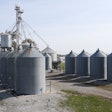According to the Dutch Feed Industry Association, Nevedi, 13.6 million metric tons of compound animal feed was produced in the Netherlands in 2010. Of that amount, 7.5 million metric tons, or nearly 60%, was produced by just five companies – about 7% of the total number of feed producers in the Netherlands.
While there are a number of smaller feed producers in the Netherlands, if the current trend is any indication, feed production in the Netherlands may be handled by just a few large companies in the not-too-distant future. In August of 2011 it was announced that global powerhouse Cargill planned to purchase the Rotterdam-based company Provimi. However, Cargill was not the only company interested in Provimi; Netherlands-based Nutreco and DSM (which has historical roots in the Netherlands) were early favorites to purchase the company, as well.
Producers in the Netherlands
According to Nevedi, there are currently 72 compound feed producers operating in the Netherlands. The largest five producers account for approximately 60% of feed production. The next 18 medium-size companies (60,000-500,000 metric tons) account for 30% of feed production, and the final 10% (less than 60,000 metric tons) is produced by 49 small companies.
Total revenue of Nevedi members (with 96% market share) was 4.7 billion euro in 2010. This is an increase of 200 million euro over 2009. This amount does not include export sales, nor revenue from other activities. It is common that large- and medium-size producers often have other activities in connection to feed that they offer their customers. Examples of this might be a trading company for basic materials (grains, seeds or fertilizers), or it can be joint ventures or subsidiary companies in breeding, such as laying hens or broilers.
Top producer 1: Agrifirm
Agrifirm is a cooperative with more than 20,000 Dutch farmers and horticulturalists. It offers a purchasing advantage on products like animal feed, seeds, fertilizers and pesticides. There are several Agrifirm subsidiaries at home and abroad. The total revenue of the company was almost 2 billion euro in 2010.
Agrifirm-feed is by far the largest feed producing cooperative in the Netherlands. It is the product of a 2010 merger between the northern cooperative Agrifirm and Cehave Landbouwbelang, which has its roots in the southern part of the Netherlands. The total inventory turnover in compound feed amounts for Agrifirm in 2010 was 4.4 million metric tons, including sales in Germany and Belgium.
A few years ago both companies were serious competitors and a merger was almost unthinkable. However, this may be seen as a demonstration of the Dutch mentality to be a trading nation when principles and sentiments can be set aside and there are financial profits to be made. The merger was actually a logical one. In the north there were primarily dairy farmers, and the south was known for its concentration in pigs. Poultry was strong in both regions.
Mergers are becoming more common in the Dutch feed market. Vitelia, a cooperative based in Oirlo, the Netherlands, recently merged with SaWeCo and Boerenbond Ysselsteyn. Although the merger did not move Vitelia into the “large producer” class, it did jump Vitelia up to the position of fourth largest cooperative in the Netherlands (Table 1).
Top producer 2: De Heus Feed
De Heus Feed is a private, family-owned company that was founded in 1911 and for many years operated as a regional feed company. Since 2005 it has embarked on an aggressive program of international expansion. It now has production facilities in Poland, Russia, Egypt, Ethiopia, South Africa and Vietnam.
Headquartered in the center of the Netherlands, in 2010 De Heus produced over 3 million metric tons of feed at its locations worldwide. Of that amount, 1.9 million metric tons was produced at 10 locations in the Netherlands. De Heus Feed currently employs 1,700 employees worldwide, 575 of which are in the Netherlands.
Top producer 3: ForFarmers
The Dutch cooperative feed producer ForFarmers reached a record inventory turnover in 2010 of 2.4 million metric tons of compound feed from all of its facilities, with 1.2 million metric tons being produced in the Netherlands. The cooperative has five production locations in the central eastern part of the Netherlands and five in Germany. Total revenue for 2010 for all of its operations was 4.2 billion euro.
ForFarmers has several subsidiaries and joint ventures. An important one is Cefetra, an international trading and logistic service company in feed, food and fuel. Cefetra’s profit in 2010 was 40 million euro, with a record inventory turnover of 18.9 million metric tons of goods. ForFarmers recently announced its intent to concentrate more heavily on its feed operations as well as being “open to mergers or acquisitions.”
Top producer 4: Hendrix UTD
Hendrix UTD is a private company, a subsidiary of the worldwide feed production company Nutreco. The Hendrix headquarters is in the east of the Netherlands, close to the border of Germany. Hendrix UTD has 10 production locations with a total turnover of 2.9 million metric tons of feed, including mills in eastern Germany. Feed production in the Netherlands was 1.1 million metric tons in 2010.
In eastern Germany the company focuses on supplying individual feed ingredients to large pig and dairy farms. In those cases, they also focus strongly on advising services for management of large farms; however, the farmers are free to buy feed ingredients from external traders. This style is contrary to the traditional advising model where advisory services are directly connected to purchase of the advising company’s compound feed.
Top producer 5: Boerenbond Deurne
At 600,000 million metric tons produced in 2010, the cooperative Boerenbond Deurne is the fifth largest feed producer in the Netherlands. In recent years it has established a separate trading company, Braco feed, for feed materials. In addition, it is franchising a shop for the general public, selling all items needed in building and maintaining houses.
An interesting note is that Boerenbond Deurne owns a weekly newspaper for the region which goes back 110 years and is tied to the origin of the cooperative. At the time, a Catholic priest saw the poverty of the peasants and the need for cooperation among them. He also saw the need for education and improving management. The slogan of the priest was “pray and work, read, calculate and keep-book.” To this day, these words appear on the corner of the front page of the newspaper.
Other feed considerations
Another important source of feed in the Netherlands is wet by-products. These consist of products derived from the grain, potato, sugarbeet, dairy and other food processing industries. In 2010 these industries supplied 5.75 million metric tons of product. Calculated to a dry matter content of compound feed, this is comparable to 1.25 million metric tons. The majority of these wet by-products are used in pig production (3.35 million metric tons). This is mainly wheat starch, potato peelings, whey products and wheat yeast concentrate.
The use of these wet by-products is beneficial for the producing companies, as well as for the pig and dairy farmers. Producers can sell the by-products while saving costs for drying. At the same time, the farmers benefit from low-cost feed. Due to a relatively high water content, it is important that transport remains within limits. In this case, the small size of the Netherlands is an advantage.
Article: World Feed Panorama: Expensive grain slows industry expansion

















